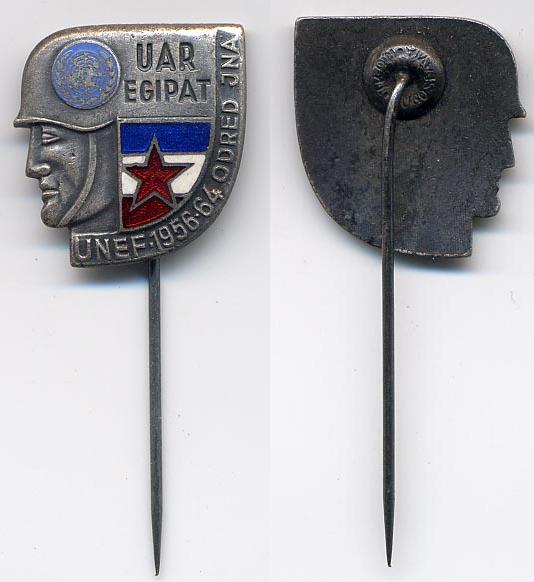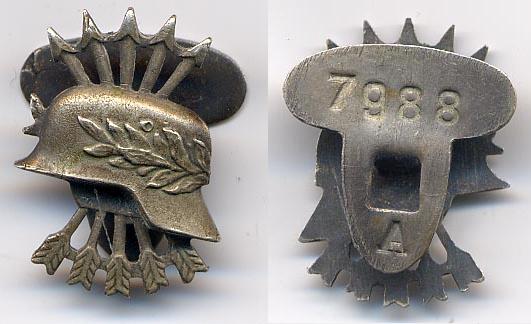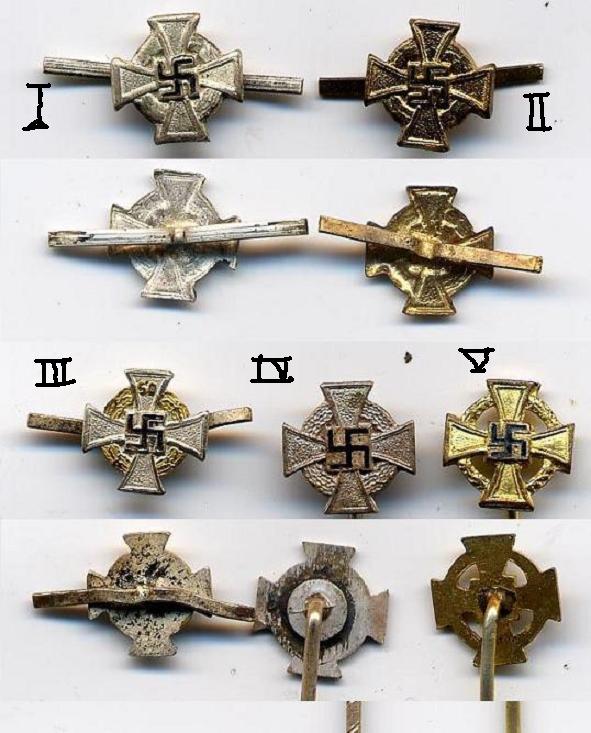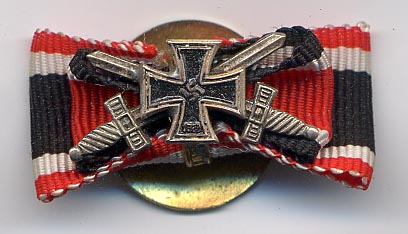-
Posts
719 -
Joined
-
Last visited
-
Days Won
1
Content Type
Profiles
Forums
Blogs
Gallery
Events
Store
Posts posted by Peter J
-
-
Dietrich, thanks for trying to sort this out. I think we have to be very careful and use the correct term, when describing a specific detail i.e. beading flaw or dent row.
"Yes, Peter, it is. I have such an example in the article and that one was the key in clearly finding out that the beading flaws of the A-Type and the B-Type (late) are not of the same pattern. This must be a very late one and might very well be "Made in England" from the die where Prosper witnessed the sale"
My question was in regards of the "un-flawed" (beading) B-type, how can a cross without beading flaws be compared to a flawed ditto, in order to establish differences in the flaws?
KR
Peter
0 -
"The models of the B-Type, which are the 935-4, 935 (magnetic and unmagnetic), incuse 800, 800, 800-4 and the very late (and again beading flawed ) unmagnetic ones and the first 57's ALL have the dent row and the 6-9 o'clock beading flaw BUT not the 9-12 o'clock knee flaw of the A-Type"
Dietrich, I suppose this is a valid also for one unmarked, unmagnetic, dent row, void of kneeflaw at 9-12 o'clock, but without beading flaws? Where in the timeline does this fit, these crosses are usually refered to as "heavily flawed"?
I would like to thank all participants in this thread for their efforts in making this an interesting topic.
KR
Peter
0 -
Hi Kevin,
I can't see anything wrong with this piece, except for the price
 The embroided motif should be in ordinary cotton-thread, as seen on this one.
The embroided motif should be in ordinary cotton-thread, as seen on this one.KR
Peter
0 -
Thanks for your nice comments

Rick, I don't think I'll be able to find out the name, but I'll see what I can do.
Out of curiosity, what indicates a 2nd bar to this one?
Hang in there Gerd, you never know what a birthday might give

KR
Peter
0 -
My mistake, the 3rd ribbon is for the Order of the White Rose

KR
Peter
0 -
Santa dropped by yesterday in the shape of a collector friend. This is what he left behind

Finnish Freedom Cross 2nd class
Finnish Freedom Cross 3rd class
Finnish Order of the Lion Knight 1st class
Winter War Medal 1939-40
Danish Dannebrogen
Norwegian Order of Olav
Swedish Order of the Sword
The size of this bar is really neat, similar to the German saw-on ribbon bars.
KR
Peter

 0
0 -
Nick, I wouldn't mind these rules being applied on all threads

KR
Peter
0 -
Hi Francois,
That would be the Flieger Technische Vorshulen. The position of wear is correct, although most of the trade patches were worn on the lower part of the left arm.
KR
Peter
0 -
May the force be with you

Good luck
Peter
0 -
Hi Michael,
This is the closest I can get

KR
Peter

 0
0 -
Thanks Pat

KR
Peter
0 -
Hi Pat,
Very nice devices
 . Could you please do me a favour and check the reverses to see if they are solid or hollow?
. Could you please do me a favour and check the reverses to see if they are solid or hollow?KR
Peter
0 -
Sorry James for not getting your name right
 0
0 -
Hi Chris,
I wish I could be of more assistance, but I'm only passing on the info found in Angolia's 2nd vol. Whether or not this is a correct statement, I can't tell. But until contradicting info surface, what are our options?

KR
Peter
0 -
Both classes were designed by Professor Raemisch.
KR
Peter
0 -
-
-
Hi Joe,
That's an odd pin, the swords makes no logic presented like this. That is unless there's an arrangement on the reverse, making it possible to attach multiple ribbons. I've posted two images to illustrate this.
I've also posted a couple of different 9mm devices for comparison. I personally don't like the hollow stamped version. As you can see, #III and IV have a double row of oakleaves, the hollow type a single row, very poorly defined.
KR
Peter
0 -
Kevin, I just confirmed the old saying "Think before you talk"
 Another theory down the drain
Another theory down the drain  . That leaves me without options, who knows, perhaps it's randomely put together, ohh terrible thought
. That leaves me without options, who knows, perhaps it's randomely put together, ohh terrible thought 
KR
Peter
0 -
Interesting thread and rather superb examples Gentlemen. The initial bar.. Anyone want to venture a guess as to nationality? A rather perplexing combination!!?
I'll give it a try. A Swedish military doctor, who volontarely served in the German army as a doctor. That would explain the EK2. If the Red Cross administrators also were eligable for the EK, he could possibly have been part of a Red Cross delegation, with the task of inspecting the POW camps. That would explain the Preussian and Austrian decorations. Climbing in ranks within the Red Cross he then recieved the post-1918 awards, which would explain the multitude of awarding countries. Plausible?
I'm amazed by the knowledge amongst members in regards of precedence. A medal bar is shown and in a flash the correct order is announced. I guess I have a long way to go
 . Kevin, thanks for your heads up on the Medical Merit Cross. The mini bar you illustrated is a good example of my confusion, I would have thought the Bulgarian Order to be positioned in front of the Preussian Red Cross medal. I realize that regulations differs when comparing countries and that the chain presented by me most likely is Swedish, but does the arrangement seem correct regarding precedence?
. Kevin, thanks for your heads up on the Medical Merit Cross. The mini bar you illustrated is a good example of my confusion, I would have thought the Bulgarian Order to be positioned in front of the Preussian Red Cross medal. I realize that regulations differs when comparing countries and that the chain presented by me most likely is Swedish, but does the arrangement seem correct regarding precedence?KR
Peter
0 -
I'm very pleased to have added this little baby to my collection, member of the Spanish Blauen Division that fought on the Eastern front. The shape of the button isn't really German design and the A would hardly be described as a typical Assman logo. Is it safe to assume this piece was produced in Spain and if so, when did the production start?
KR
Peter

 0
0 -
I've posted this thread on the Imp. Iron Cross forum, perhaps it will get some additional attention here.
http://gmic.co.uk/index.php?showtopic=10877
KR
Peter
0 -
Thanks Dan, but I don't think my few enameled minis will render a coronation, there are better candidates on this forum

I brought home the chain from the same individual today. It's a 12-piece chain with 5 decorations missing. They are all related to the Red Cross. From what I've been told, this guy was a doctor, which would explain the wide range of countries. I presume the 4 decorations on the bar initially were positioned to the right on the voided places in a reversed order i.e. the Wasa on the extreme right. That still leaves a void between the Hungarian and Rumanian award? I'm not sure about the pecedence, but if we except this chain being read from right to left, is this set-up correct?
Unfortunately the Turkish medal is missing from the devise. I've also failed to identify the medal between the Turkish and Hungarian award, any ideas?
KR
Peter

 0
0 -
Thanks again guys

Paul and Christophe, I appreciate your correction, don't know what I was thinking about
 . I'd like to add some thoughts to this topic of rosettes and stripes.
. I'd like to add some thoughts to this topic of rosettes and stripes. To my knowledge, these features never appeared on Swedish miniatures, at least not the ones manufactured here. This is evident on this bar, were the Bulgarian and French decoration is correct. Should the system be applied on the Swedish Wasa, it should have a rosette, given it's class (Knight 1st cl.) The enclosed image below is another illustration. The image at the top shows a bar with rosettes on all 4 Knight 1st class, including the Swedish North Star. My assumption is that it is made in Norway, hence the position of the Order of Saint Olaf. This could also explain the incorrect Cross of Freedom with the red cross and the incorrect precedence of the Finnish decorations. I have no experience in minis from Iceland, but all the other Nordic countries, except Sweden, used the system with rosettes and stripes.
Gerd, I know you fancy enamel. Stay tuned and I'll present the rest of the minis from this individual later on this week

Daniel, the cross is 15.6mm.
Terry, you're on the right track
 .
. KR
Peter

 0
0






The Great RK debate ?
in Germany: All Eras: The Iron Cross
Posted
Dietrich, I'm almost as lost as you are . When you made a reference to the difference in the beading flaws, when comparing a A- and B-type, I assumed you meant the flaws at the top of the beading, hence my question. Your additional images leds me to believe you meant the dent row. The differences in these rows are clearly visible, so that part needs no further elaboration. I probably got this all wrong, but isn't the dent row a charactaristic solely for the B-type? If that's the case, how is a comparison to an A-type possible, if it is void of this dent row?
. When you made a reference to the difference in the beading flaws, when comparing a A- and B-type, I assumed you meant the flaws at the top of the beading, hence my question. Your additional images leds me to believe you meant the dent row. The differences in these rows are clearly visible, so that part needs no further elaboration. I probably got this all wrong, but isn't the dent row a charactaristic solely for the B-type? If that's the case, how is a comparison to an A-type possible, if it is void of this dent row?
KR
Peter